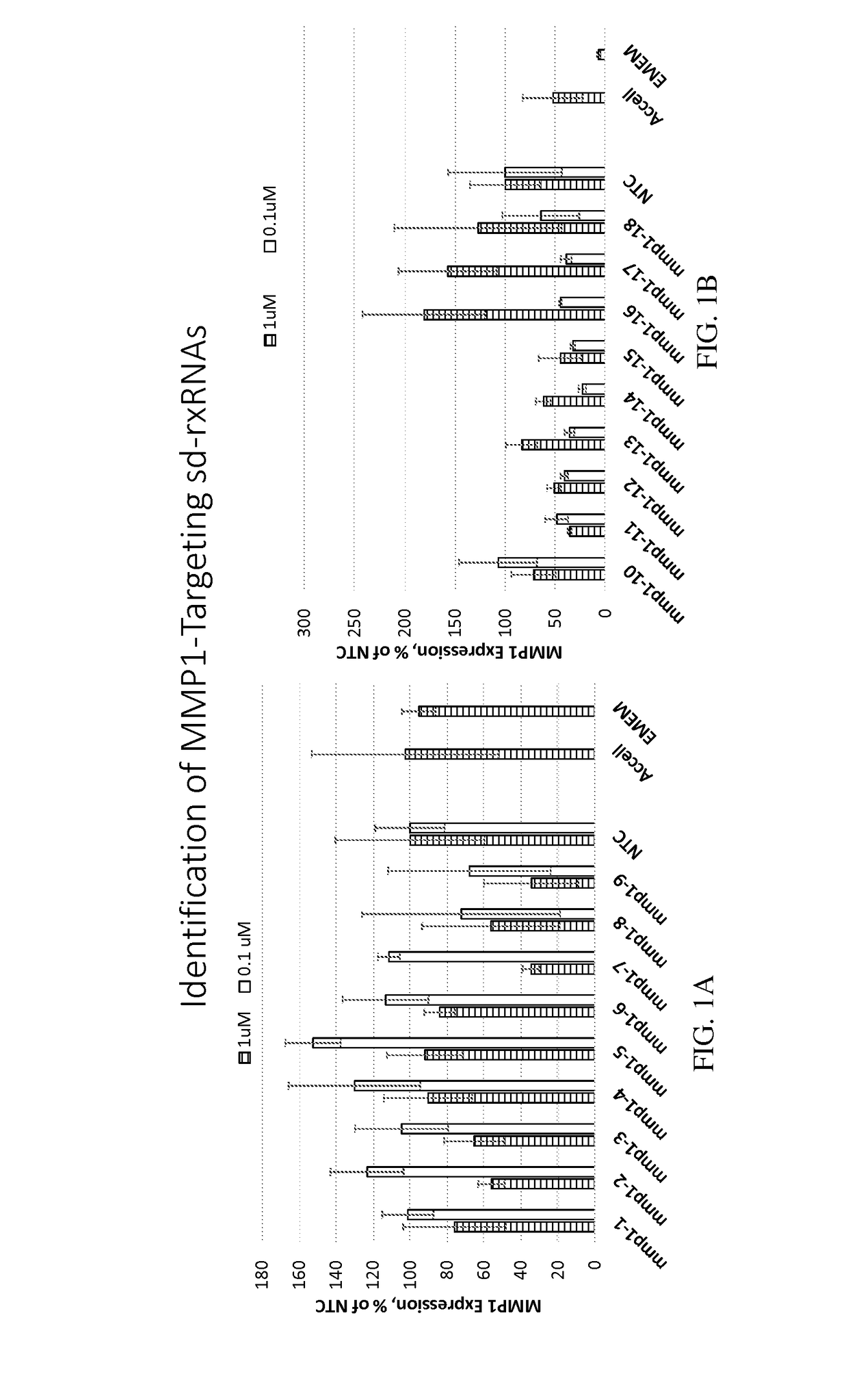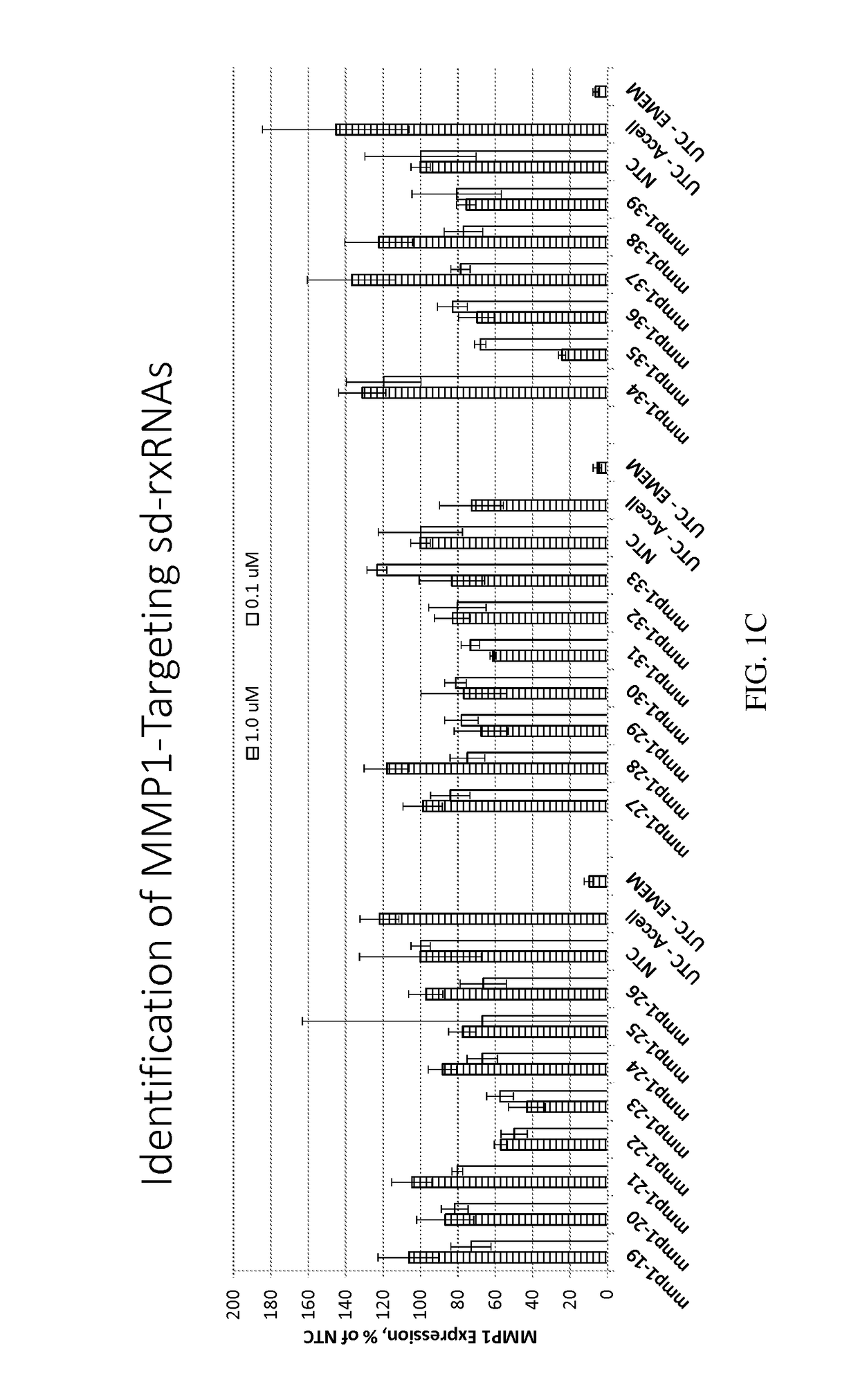Methods for treating aging and skin disorders using nucleic acids targeting tyr or mmp1
a nucleic acid and skin technology, applied in the field of nucleic acid molecules, can solve the problems of difficult to achieve the intended efficient inhibition of gene expression (including protein synthesis) using such compositions in vivo, the delivery of these compounds to cells and tissues, and the inability to pass through the cell-membrane of rod-type molecules
- Summary
- Abstract
- Description
- Claims
- Application Information
AI Technical Summary
Benefits of technology
Problems solved by technology
Method used
Image
Examples
example 1
Identification of MMP1-Targeting sd-rxRNAs
[0474]sd-rxRNAs targeting MMP1 were designed, synthesized and screened in vitro to determine the ability of the sd-rxRNAs to reduce target gene mRNA levels. The sd-rxRNAs were tested for activity in HT-1080 cells (human fibrosarcoma cell line, 10,000 cells / well, 96 well plate). HT-1080 cells were treated with varying concentrations of a panel of MMP1-targeting sd-rxRNAs or non-targeting control (NTC) in serum-free media. Concentrations tested were 1 and 0.1 μM. The non-targeting control sd-rxRNA (NTC) is of similar structure to the MMP1-targeting sd-rxRNA and contains similar stabilizing modifications throughout both strands. Forty-eight hours post administration, cells were lysed and mRNA levels determined by the Quantigene branched DNA assay according to the manufacture's protocol using gene-specific probes (Affymetrix). FIGS. 1A-1C demonstrate that MMP1-targeting sd-rxRNAs, found in Tables 1 and 2, significantly reduce target gene mRNA le...
example 2
Dose Response Analysis of MMP1 Targeting sd-rxRNAs in HT-1080 Cells
[0476]MMP1-targeting sd-rxRNAs were tested in an in vitro dose response study. The sd-rxRNAs were tested for activity in HT-1080 cells (human fibrosarcoma cell line, 10,000 cells / well, 96 well plate). HT-1080 cells were treated with varying concentrations of MMP1-targeting sd-rxRNAs or non-targeting control (NTC) in serum-free media. Concentrations tested were 1, 0.5, 0.1, 0.05, 0.025 and 0.01 μM. The non-targeting control sd-rxRNA (NTC) is of similar structure to the MMP1-targeting sd-rxRNA and contains similar stabilizing modifications throughout both strands. Forty-eight hours post administration, cells were lysed and mRNA levels determined by the Quantigene branched DNA assay according to the manufacture's protocol using gene-specific probes (Affymetrix). FIGS. 2A-2B demonstrate dose response analysis of lead MMP1-targeting sd-rxRNAs in vitro in HT-1080 cells. Data were normalized to a house keeping gene (PPIB) a...
example 3
Identification of TYR-Targeting sd-rxRNAs
[0477]sd-rxRNAs targeting TYR were designed, synthesized and screened in vitro to determine the ability of the sd-rxRNAs to reduce target gene mRNA levels. The sd-rxRNAs were tested for activity in SK-MEL-5 cells (human melanoma cell line, 10,000 cells / well, 96 well plate). SK-MEL-5 cells were treated with varying concentrations of a panel of TYR-targeting sd-rxRNAs or non-targeting control (NTC) in serum-free media. Concentrations tested were 1 and 0.1 μM. The non-targeting control sd-rxRNA (NTC) is of similar structure to the TYR-targeting sd-rxRNA and contains similar stabilizing modifications throughout both strands. Forty-eight hours post administration, cells were lysed and mRNA levels determined by the qPCR according to the manufacture's protocol using gene-specific TaqMan probes (Applied Biosystems). FIG. 3 demonstrates that TYR-targeting sd-rxRNAs, found in Tables 3 and 4, significantly reduce target gene mRNA levels in vitro in SK-M...
PUM
| Property | Measurement | Unit |
|---|---|---|
| Fraction | aaaaa | aaaaa |
| Hydrophobicity | aaaaa | aaaaa |
Abstract
Description
Claims
Application Information
 Login to View More
Login to View More - R&D
- Intellectual Property
- Life Sciences
- Materials
- Tech Scout
- Unparalleled Data Quality
- Higher Quality Content
- 60% Fewer Hallucinations
Browse by: Latest US Patents, China's latest patents, Technical Efficacy Thesaurus, Application Domain, Technology Topic, Popular Technical Reports.
© 2025 PatSnap. All rights reserved.Legal|Privacy policy|Modern Slavery Act Transparency Statement|Sitemap|About US| Contact US: help@patsnap.com



